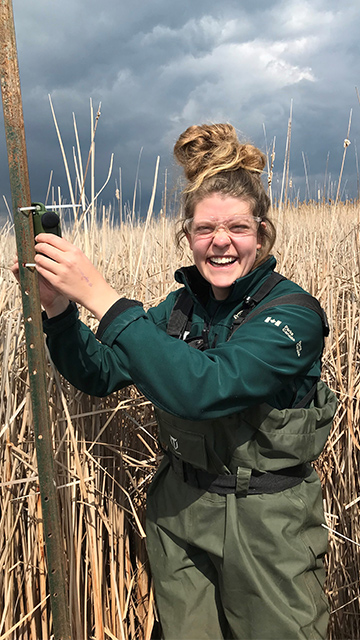Meet Emma Burbidge
Point Pelee National Park

Job Title
Acting Resource Management Officer/Geomatics Technician.
What was your education/career path?
I was raised to be a naturalist. My father started taking me birding when I was about one year old, taught me to identify birds by sound at 5 years old, and spent countless hours testing me on every plant and rock we passed. He brought me along to naturalist club meetings, bioblitzes, Christmas Bird Counts, marsh bird point counts, and breeding bird atlas surveys. When it came time to choose between the sciences or the arts in CEGEP (college), though, I didn’t know what to do. I couldn’t see myself in any of the “classic” scientific careers and didn’t think that I could make a career out of birding. I followed the arts route, eventually pursuing a Bachelor of Arts in Archaeology at McGill.
The next few years were difficult. My grades were good, but I felt like I was going through the motions. I couldn’t summon any passion for my courses and struggled with low self-worth. Then, in the spring of my third year of university, I was fortunate enough to work as a birding hike leader for the Friends of Point Pelee. It was like someone had flipped a switch inside of me! I applied to transfer into Wildlife Biology, and just had to complete a year of freshman science prerequisite courses first. It was challenging to re-enter the science world after five years away from it, but I loved it! Halfway through the year, though, my application was rejected. I was told that while my grades were above the requirement, they were inferior to the grades I had been receiving in the Arts. This signalled to them that “Science may just not be for [me]”.
I begrudgingly returned to Arts to finish my Archaeology degree. The summer before my final semester, though, I got a job as a student interpreter at Point Pelee National Park and met the resource conservation team. I knew then that I would do whatever it took to end up working in resource conservation with Parks Canada and was beyond fortunate to be offered a spot as a resource conservation student that following winter. Since then, I have gained more experience and hands-on training than I could have ever imagined. I have had amazing role models at the park who have taken the time to teach me and to support my extra-curricular education (like a post-graduate certificate in Geographic Information Sciences). It turns out that science is, actually, for me!
What drew you to Point Pelee? When did you first start working at Point Pelee National Park?
Birds! I grew up in Quebec, but I’ve been visiting Point Pelee National Park for the spring bird migration (and the park’s Festival of Birds) every year since I was 5 years old. I started working as a French bird hike leader for the Friends of Point Pelee when I was 22, then as a student interpreter for the park a couple of seasons later. During my summer as an interpreter, I discovered and fell in love with resource conservation. I volunteered to help with nest counts and five-lined skink monitoring, and was lucky enough to be offered a student position with the resource conservation team the following winter. After accepting the position, I finished my final exam in Montreal, packed up my apartment, and drove to Leamington, Ontario. I’ve been here ever since!
What do you do for Parks Canada?
As the acting geomatics technician, I work heavily with spatial and non-spatial data to support projects and goals in resource conservation, visitor experience, and park maintenance. I collect, manage, analyse, and interpret data with geographic information systems and remote sensing technologies. Some days, this means spending a day cleaning up databases, other days it means creating printed and digital maps, and other days it means piloting a drone to collect remotely sensed data and aerial imagery. I also get to assist with departmental and park-wide operations such as hyperabundant species management, habitat restoration, and prescribed burning. Before this position, I spent three years working on the park’s Marsh Restoration Project, which included everything from collecting data on water quality from a canoe to driving heavy aquatic machinery. I then spent a season as the Interpretation Coordinator for the park, leading a team of interpreters to develop and deliver presentations, guided tours, school programs, and special events.
What would you tell a young girl about working in science, technology, engineering and mathematics (STEM)?
Don’t let anyone tell you that you are not cut out for a career in STEM. Spend time getting to know yourself – your passions, your strengths, and your weaknesses – and let those guide you. You will inevitably struggle with certain concepts, tasks, or projects. That’s life! But the truth is that nobody expects you to know everything all the time, and that you learn way more from your mistakes than you do from your successes. Take your time, apply yourself, and learn from those around you.
- Date modified :